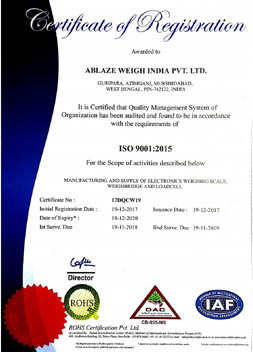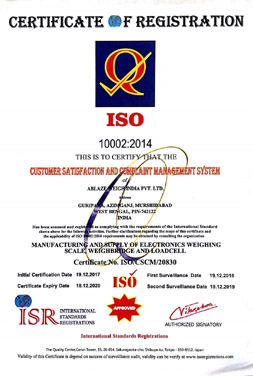Load Cell

Product Specification:
The heart of any weighing system is the load cell. Load cells are highly accurate transducers which provides the user with information not generally obtainable by other technology due to commercial factors.Load cells are designed to sense force or weight under a wide range of adverse conditions; they are not only the most essential part of an electronic weighing system, but also the most vulnerable. In order to get the most benefit from the load cell, the user must have a thorough understanding of the technology, construction and operation of this unique device. In addition, it is imperative that the user selects the correct load cell for the application and provide the necessary care for the load cell during its lifetime.
Understanding these important issues and properly maintaining the load cells will ensure trouble-free weighing for a long period of time.
Wikipedia states:
A load cell is a transducer that is used to convert a force into electrical signal. This conversion is indirect and happens in two stages. Through a mechanical arrangement, the force being sensed deforms a strain gauge. The strain gauge converts the deformation (strain) to electrical signals. A load cell usually consists of four strain gauges in a Wheatstone bridge configuration. Load cells of one strain gauge (quarter bridge) or two strain gauges (half bridge) are also available. The electrical signal output is typically in the order of a few millivolts and requires amplification by an instrumentation amplifier before it can be used. The output of the transducer is plugged into an algorithm to calculate the force applied to the transducer."
Double Ended Shear Beam:
This is constructed from electro less nickel plated heat treated tool steel suitable for harsh applications. Cup and steel ball mounted mechanism is self-restoring and self-centering. Transient voltage protection is provided for protection against lightning and line voltage faults.
Technical Specification:
| Technical Specification Name | Technical Specification Details |
| Rated Capacities (Emax) | 5, 30t |
| Sensitivity | 2.0 + 0.002 mV/V |
| Accuracy class | C1-C5 |
| Zero Balance | + 1% F.S |
| TCO | + 0.02^ F.S./ 10 oC |
| TC Span | + 0.02% F.S./10 oC |
| Input Impedance | 750 + 10 |
| Output impedance | 702 + 3 + 703 + 5 (L > 15m) |
| Insulation impedance | > 5000 m |
| Temperature range, compensated |
-10 oC ~ + 40 oC |
| Temperatue range, Operating | -30~ + 70 oC |
| Maximum safe overload | 150, 120 (40~50) % F.S. |
| Ultimate overload | 300, 2000 (40-50t) % F.S. |
| Excitation recommended | 10-12 V DC |
| Exitation, Maximum | 15V DC |
| Protection class | IP 67 (5t), IP 68 (10-50t) |
| Construction | Alloy Steel, Stainless Steel |
| Cables | Length = L: 5.2 m (5t), 8m (10t), 10m (15t), 10/12m (20t); 12/15m (25t), 12/16 m (30t), 16m (40-50t), Diameter: 6mm |



